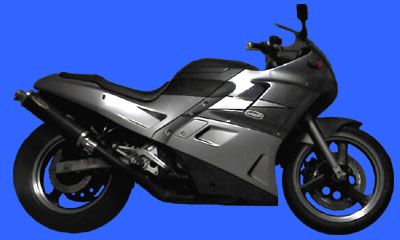|
This article was written by Henrik Morkner,
posted on the VFR List.
It offers guidance to anyone wanting to
repack any exhaust canister.
I just repacked my TBR C2 cf can on my '95 since it was at 12K miles.
The procedure is straight forward with a little help (thanks Chris
Salazar).
-
Remove the can from the bike (simple, just unbolt bracket, pull springs).
-
Use a variable speed drill and pick a drill size slightly bigger than the
rivets that circle the two (2) ends of the can.
-
Slowly drill out the rivets. Start with the back end since it's not connected
to the center tube. Once the top of the rivet comes free then stop since
the bottom half of the rivet will simply fall out later when it's apart.
-
Remove all the rivets on both ends (NOT length wise though). Pull the end
cap off then gently twist and turn the cf shell until it slips off.
-
Look for burned through areas of the existing packing. The stuff use at
TBR is pretty good quality stuff. Mine had no obvious burned through areas.
As I began to unwrap it, the forward-top portion had a golf ball size pocket
forming that would have gone all the way through in a few more miles by
my guess.
-
Remove all the old packing and clean the center tube, cf shell, and the
ends.
-
Replace the packing with loose or sheet type packing. I was told by the
shop that the loose, ceramic packing was the best, so that's what I bought.
However, the fiberglass stuff that comes in 1" thick sheets is probably
easier to install and is more like the OEM. BTW the TBR C2 cf took 1.5
bags of the stuff since it's bigger than most.
-
Carefully wrap the ceramic packing around the bare center tube to the approximate
size of the cf shell. I used some string to hold it together (just till
you get the can shell back on).
-
Slip the cf can over the center tube and packing. Then I took more packing
and carefully put it in layer by layer while pushing it down gently with
a rod and shaking the whole can.
-
Put the end cap back on and I used a standard Stanley rivet gun to replace
the rivets. I used aluminum rivets since their are easier to squish and
the cf is brittle and could be crushed by the steel ones.
-
Re-mount the canister and power-up.
I noticed that my pipe has a slightly lower, baritone sound with the ceramic
packing as opposed to the fiberglass.
Available from TBR - a repack kit #005-10038.
Good Luck
-Henrik '95 VFR750FS Palo Alto, CA
An Additional Comment by David M. Matthew '91 VFR750F-(RC36)
Alloy or CF silencers that use "glass pack" style mufflers (canisters)
need repacking at some point. Some OME canisters/silencers use metal baffles
and do not therefore need re-packing as there is nothing to pack... and
no way of accessing the innards anyway.
Special Addendum by Rob McKinnon
First off, fibreglass packing is at least a pain. Doesn't last long
enough no matter who sells it to you. I tried fibreglass in the Yosh slip-ons
on my '86 vfr for 5 or 6 seasons and had to repack every year.
Then I discovered "SUPERWOOL 607". It is an industrial insulation for
hi-temp applications such as turbocharger blankets on large gas compressors
(2000+ HP). It is also used to wrap steel pipe prior to stress-relieving
weld joints. It is a "Refractory Ceramic Fiber product" made from "Crystalline
silica formed at over 1800' F', according to the manufacturer. It comes
in a bulk blanket form, about 1.25 inches thick, which I cut to size easily
with ordinary household scissors.
This stuff does not burn out period. I have a small plastic grocery
bag full and have only repacked the "old' vfr mufflers twice in 8 years.
Once the first time and once when I had the pipes disassembled for nickel
plating and polishing the canisters. Even then, the packing was in great
shape physically, just dirty is all.
If you can contact some industrial (oilfield) insulators or (pipe) stress
relievers locally, they should have it in stock. If not, here is the manufacturers
information: Thermal Ceramics, Agusta Ga. at 800-722-5681.
They will probably give you a line about it not being meant for this
application. Well they are right, it isn't. In fact it is far superior
to anything you will ever find.
NOW FOR THE SAFETY WARNING!
IT IS A SUSPECTED CARCINOGEN AND SHOULD BE HANDLED WITH A MASK AND GLOVES,
WASH CLOTHING AFTERWARD. Again this is from the manufacturer's label and
I assume no responsibility for anything at all. You are on your own!
That being said, SUPERWOOL 607 will be the last packing you will buy.
Period. It works for me. And No, I cannot get you any. I had to ask someone
nicely for my tiny stash and I expect it to last at least 20 years or more
at the rate it's going!
Hope this helps.
Special Addendum by Greg Leach
I have some info that may help some of the DIY people. The report on
repacking exhaust cans tells of a permanent packing material called superwool,
but does not tell where to get the stuff. Superwool goes by various trade
names, but is essentially a flame (heat) proof space-industry spin off
that looks like a 1" thick roll of white cotton. This material comes in
24" wide rolls, and sells for about $2.50 a square foot. Most applications
need 2 square feet. This material can be found at any store that sells
ceramic/pottery supplies like clay, glaze, and kilns. Do wear gloves and
a mask when handling it because it does contain fibres that will easily
embed in your hands or lungs. I hope this helps, and feel free to edit
as needed.
Greg Leach, 95 VFR
|
Exhaust
Can Surgery
Here's some pics of my two
brothers can, and what it all looks like when pulled to bits,
for those who are curious...

new superwool
material

inner core

bands that hold
can together
-rivited to the
shell

the carbon fibre
shell
I didn't take any shots of
the material that came out as I didn't want to
be handling the material
any further than from the exhaust can to the garbage bin.
The stock two brothers material
was a stainless steel wool in the centre with
fireglass wrapped around
the outside through to the carbon fibre shell.
It did not appear physically
deteriorated, but I didn't stick around playing with the stuff.
Now that I have installed
the superwool it becomes obvious that the original
two brothers packing was
long past it's due date, as the sound is infinitely better.
A deeper note, as Hendrik
above found with his pipe, and not
so mind-numbingly loud but
still a great sound.
Stay tuned as I'll post .ra
files to 'demonstrate' soon.
A note on safety...
I recently spoke to the manufacturer
of Superwool, who
said that it was the safest
fibre material known to mankind,
but that you would want
to wear gloves to prevent the fibres
getting into your skin --but
that anything that went into the lung
would just dissolve.
Perhaps the warning in the
above discussion group comes about just
because it is a fibre, like
standard fibreglass sheeting or insulation.
Many of these sorts of materials
are now being found out to be carcinogenic.
Well, I still don't feel
safe enough about this stuff to not wear
an industrial facemask while
handling it (better safe than sorry!).
However, it does make me
feel slightly better that research studies
show that it's not as bad
as some of the other fibrous stuff out there.
It's probably going to be
in my exhaust for a long time, so just as well...
If standard fibres degrade
and need repacking in about a year,
then they must be ejecting
out of the exhaust a lot more fibrous material
(that you could be breathing
in) than any product that
maintains its integrity
much longer in the can.
-ozbrickie
|
|

 Made
in Sydney, Australia
Made
in Sydney, Australia


